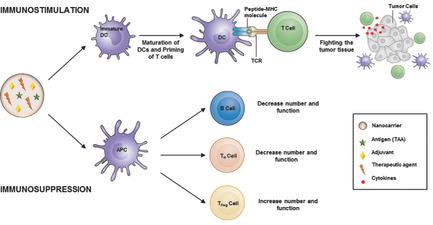当前位置:
X-MOL 学术
›
Small Methods
›
论文详情
Our official English website, www.x-mol.net, welcomes your
feedback! (Note: you will need to create a separate account there.)
Immunostimulation and Immunosuppression: Nanotechnology on the Brink
Small Methods ( IF 10.7 ) Pub Date : 2018-03-24 , DOI: 10.1002/smtd.201700347 Flavia Fontana 1 , Patrícia Figueiredo 1 , Tomás Bauleth-Ramos 1, 2, 3, 4 , Alexandra Correia 1 , Hélder A. Santos 1, 5
Small Methods ( IF 10.7 ) Pub Date : 2018-03-24 , DOI: 10.1002/smtd.201700347 Flavia Fontana 1 , Patrícia Figueiredo 1 , Tomás Bauleth-Ramos 1, 2, 3, 4 , Alexandra Correia 1 , Hélder A. Santos 1, 5
Affiliation

|
Immunotherapy is revolutionizing current therapies in cancer and in autoimmune diseases, showing impressive results in clinical trials. Recently, the development of innovative nano‐biomaterials has been focusing on the interactions between such materials and the immune system, both in the adaptive and innate branches. Biomaterials can display immunostimulative, neutral, or immunosuppressive interactions. Nanoparticles displaying immunostimulative potential are employed in the formulation of cancer vaccines, while immunosuppressive materials are being researched for the development of vaccines able to induce tolerance in autoimmune diseases. Here, the properties influencing the immunomodulation effect of nanomaterials are analyzed, followed by a detailed review of the recent applications of nanomaterials for the delivery of antigens, adjuvants, chemotherapeutics, and immunomodulatory drugs.
中文翻译:

免疫刺激和免疫抑制:处于边缘的纳米技术
免疫疗法正在彻底改变目前在癌症和自身免疫性疾病中的疗法,在临床试验中显示出令人印象深刻的结果。最近,创新的纳米生物材料的开发一直集中于这种材料与免疫系统在适应性和先天性分支中的相互作用。生物材料可以显示免疫刺激,中性或免疫抑制相互作用。显示出具有免疫刺激潜力的纳米颗粒被用于癌症疫苗的配制中,同时人们正在研究免疫抑制材料来开发能够诱导自身免疫疾病耐受性的疫苗。在这里,分析了影响纳米材料免疫调节作用的特性,然后详细综述了纳米材料在抗原,佐剂,
更新日期:2018-03-24
中文翻译:

免疫刺激和免疫抑制:处于边缘的纳米技术
免疫疗法正在彻底改变目前在癌症和自身免疫性疾病中的疗法,在临床试验中显示出令人印象深刻的结果。最近,创新的纳米生物材料的开发一直集中于这种材料与免疫系统在适应性和先天性分支中的相互作用。生物材料可以显示免疫刺激,中性或免疫抑制相互作用。显示出具有免疫刺激潜力的纳米颗粒被用于癌症疫苗的配制中,同时人们正在研究免疫抑制材料来开发能够诱导自身免疫疾病耐受性的疫苗。在这里,分析了影响纳米材料免疫调节作用的特性,然后详细综述了纳米材料在抗原,佐剂,











































 京公网安备 11010802027423号
京公网安备 11010802027423号